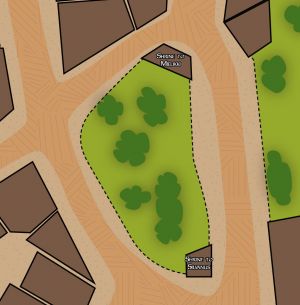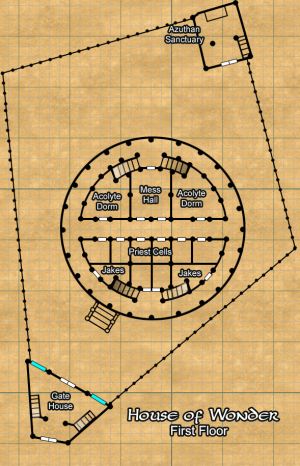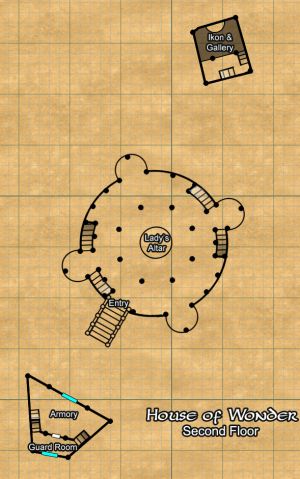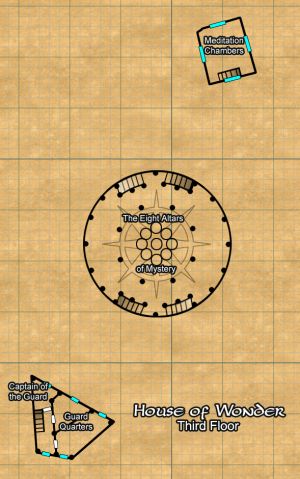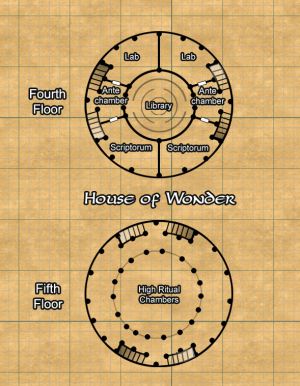Shrines of Nature
The Shrines of Nature
|
Street of Whispers, Sea Ward, Waterdeep
|
Founded 1290 DR
|
Personages
|
• Population: 14 total
8 clergy (1 druid, 2 clerics, 3 rangers, 2 priests; 6 ordained priests, 2 acolytes) 6 Needles (shrine guardians) (2 rangers, 4 guards) • High Priest (Silvanus): Oaksage Amithrel Fuindren (druid) • High Priest (Mielikki): High Ranger Faeruilin Onuskan (cleric) • Captain of the Guard: Chief Warden Ossyl Arbreen (ranger) • Noble Patrons: House Eirontalar, House Nesher, House Tarm |
Services
|
| Caretaking of the land, healing, ritual, social |
Faction Details
|
| Common Descriptors: Natural, primal, willing to fight Primary Classes: Cleric (Mielikki, Silvanus), druid, ranger, barbarian, paladin (Oath of the Ancients) Alignments: N, NG, LN, CN |
Faction Ranks
|
| • Spring Stag (Mielikki) or Acorn (Silvanus): Rank 1. You are a sworn servant of Mielikki or Silvanus, and ordained as novice clergy within the temple. You aid higher ranking priests in the sacred rites of the shrines, and perform some basic services for lay worshippers in need of one-on-one aid. • Stalker in the Green (Mielikki) or Young Oak (Silvanus): Rank 3. You are a fully ordained priest of the shrine's order, with the right to perform all the rites and services of the shrine, save those reserved for the high priest or priestess.
• High Ranger (Mielikki) or Oaksage (Silvanus): Rank 10+. You bear this title, overseeing the spiritual health of the shrines, its clergy, and the faithful, working in close partnership with your counterpart from the other shrine. |
xxx
The Dryad of the Shrines
xxx
Temple Personages
Mielikki's Clergy
| xxx xxx • Rank xxx xxx | |
| xxx xxx • Rank xxx xxx |
Silvanus's Clergy
| xxx xxx • Rank xxx xxx | |
| xxx xxx • Rank xxx xxx |
The Needles (Temple Guardians)
| xxx xxx • Rank xxx xxx | |
| xxx xxx • Rank xxx xxx |
Services
| Spell | Cost |
|---|---|
| cure wounds (1st level) | 10 gp |
| cure wounds (2nd level) | 20 gp |
| lesser restoration | 40 gp |
| prayer of healing | 40 gp |
| cure wounds (3rd level) | 45 gp |
| dispel magic | 90 gp |
| remove curse | 90 gp |
| speak with dead | 90 gp |
| cure wounds (4th level) | 100 gp |
| divination | 210 gp |
| greater restoration | 450 gp |
| raise dead | 1000 gp |
- Apprenticeship: The House of Wonder and Watchful Order cooperate to teach those with promise the arts of wizardry, fostering in them Mystran morality and the Order's operational ethics as a basic part of their training. Its mentors come primarily from the Watchful Order, and its headmaster is both a priestess of the temple and a master in the Order. Most of the apprentices do not live at the temple, although those who need such accommodations are permitted space with the acolytes.
- Ritual: The House of Wonder offers a variety of rituals for the adherents of Mystran and Azuthan faiths. Many of the standard rites of faith – birth celebrations, weddings, funerals – are performed, all with a distinctly magical flavor. But the House also offers rites for events unique to wizards and other magicians: celebrations of being accepted as an apprentice, offerings of thanks for mastering a new circle of magic, rites of passage from apprentice to journeyman to master levels of proficiency, rites of sacrifice for luck in creating a new spell or magic item, anointing of new familiars, and so on.
- Social: The House of Wonder is always open to practitioners of the Art, with the express intention of building community among those who wield arcane power. Part of the temple's goal is to foster cooperative relationships among wizards and other magi, in the hopes that it will reduce the competitive and antagonistic relationships that often lead to spell-battle. A simple social is always held after every temple ritual, and the temple also frequently sponsors "wizards' balls," social events with music, dancing, and ample amounts of delightful magic to enhance the atmosphere.
- Spells: The House of Wonder will cast the spells indicated in the sidebar.
Layout
Grounds
The grounds of the House of Wonder are surrounded by a fine gate of wrought iron, each spoke in the gate topped with the Eightfold Star of Mystra at the crosspoint. The grounds themselves are wrought of fine white marble cobblestones, with blue-white cobbles forming the mosaic of the Eightfold Star from which rises the temple.
Three buildings are situated on the grounds: the Gatehouse, a defensive structure maintained by the Knights of Mystic Fire, Mystra's order of paladins; the Shrine to Azuth, tucked away at the rear of the compound; and the House of Wonder itself, a great circular tower.
Gatehouse
Headquarters for the local chapter of the Knights of Mystic Fire, the Gatehouse defends the sole entrance to the House of Wonder.
- Gate House: First Floor. The gatehouse serves as the point of entry for the House of Wonder. A Mystran acolyte is always on duty here, ready to welcome those who come to the House, offering to help them with whatever their needs may be. Beyond the entry vestibule, a pair of Knights of the Mystic Fire await, prepared to defend the House and sound an alarm rousing their companions to the temples' defense.
- Guard Room: Second Floor. There are always at least two guards on duty in the guard room, prepared to rush downstairs to the aid of their fellows and alert those paladins in the chambers above them. They are also the guards for the armory.
- Armory: Second Floor. With armor stands supporting finely-wrought suits of chain and plate in the center of the room, and walls with many shields (all showing the sign of Mystra) and weapons, the armory is the responsibility of the Knights. Several of these items are magical, but properties of the room muffle any magical auras - only the Knights and upper clergy of the temple know which ones are enchanted.
- Guard Quarters: Third Floor. The Knights of the Mystic Fire take five-day rotations of service in the House of Wonder. While all of them have quarters elsewhere in the city, when on duty, they dwell in one of the bunks in these quarters.
- Captain of the Guard's Quarters:' Third Floor. The captain of the temple guard, Dhaelos Marganathyr, dwells here full time.
Shrine to Azuth
Like most temples to Mystra, the House of Wonder includes a small shrine to Azuth. The Waterdhavian shrine is home to a handful of Azuthan clergy, more than half of them mages, who tend to the needs of the faithful and stand out among the Mystran clergy by dint of their gray robes among the Mystran blue.
- Sanctuary: First Floor. Here the faithful of Azuth and Mystra can frequently be found in contemplation and prayer. An altar burning with many candles in glass votives, each etched or scribed with a symbol that is a form of prayer, stands to one end of the sanctuary. Eight or so feet above the altar is a small shelf on which stands a statue of Azuth. Beside the door, a set of stairs rises to the gallery above. At least one Azuthan priest can be found here at all times.
- Ikon of Azuth: Second Floor. Above the altar in the sanctuary is a statue of Azuth, long-bearded and hooded, holding a staff in one hand, and his other raised in benediction, forming the gesture that is his holy symbol, his hand alight with mystical flame.
- Gallery: Second Floor. The gallery above the sanctuary is where the faithful are often taken to speak with clergy alone, or where the clergy remain during the rites to Azuth (which the faithful gather below), so that all eyes are upon the ikon of Azuth rather than his priesthood.
- Meditation Chambers: Third Floor. The faithful are always permitted space here. Though it may be used for general meditation and contemplation, it also finds extensive use by Azuthan faithful, who offer instruction in the Art or demonstration of their own breakthroughs as part of their service to the faith.
First Floor
Set into the temple's foundation, this floor - which is wider than the others - serves as living space. Beneath it is a wide-open set of cellars, with storage space as well as a library for both apprentices and acolytes, and the teaching rooms for both temple and academy.
- Acolyte Dorms: Large open dormitories filled with bunks for the acolytes of the temple.
- Mess Hall: Eating space provided to the temple's clergy and guardians. Food is prepared off-premises and brought here to be served.
- Priest Cells: Though most of the temple clergy have dwelling places either in the nearby temple-owned row houses or simply in private dwellings elsewhere in the city, a handful of them maintain cells here. For the most part, these are either senior clergy or those responsible for teaching and overseeing the acolytes.
Second Floor
This is the main entry of the temple, a vast pillared circular chamber. In the center is a circular altar from which rises a flickering blue-white flame. Those who approach the altar find the flames parting, and the image of a serene, slightly aloof goddess - a depiction of Mystra - gazing at them from out of the flame, no matter which direction they approach the altar from.
Small side alcoves either provide access to the stairs up or down (and are usually watched over by an acolyte), or harbor small sitting areas with priests ready and able to discuss the needs of the faithful. The southermost alcove also holds a holy water font, where the faithful may purchase Mystran holy water from.
Third Floor
The Shrines of the Eightfold Star
Fourth Floor
Library & Labs
Fifth Floor
Ritual Chambers
